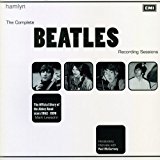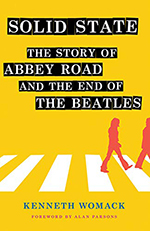- Album Songs recorded during this session officially appear on the Abbey Road LP.
- Studio:
- EMI Studios, Studio Two, Abbey Road
- Studio:
- EMI Studios, Studio Three, Abbey Road
Timeline
More from year 1969
Spread the love! If you like what you are seeing, share it on social networks and let others know about The Paul McCartney Project.
About
Since the beginning of the “Abbey Road” sessions in early July, John Lennon had not contributed much, either being unavailable following his car accident on July 1 or unwilling to participate in the recordings. On this day, he brought “Come Together“, his first composition since April’s “The Ballad Of John And Yoko“.
The first time [John] played it for us, chugging away on his acoustic guitar, it was a lot faster than the final version that made it to the album. It was Paul who suggested it be done at a slower tempo, with a “swampy” kind of sound, and Lennon went along with it uncomplainingly; he always took well to constructive
criticism.John was in a pretty good mood that day, too—he seemed to come to life when we were working on one of his own songs, rather than one of Paul’s or George’s. True, all three of them exhibited a lack of patience if it wasn’t their song—there was always a definite drop-off in interest whenever any one of them was working on another Beatle’s composition—but John was consistently the most flagrant offender.
Geoff Emerick – From “Here, There and Everywhere: My Life Recording the Music of The Beatles“, 2006
In a session lasting from 2:30 pm to 9:30 pm, they recorded eight takes of the basic track, on a four-track tape. John sang, clapped hands and played some tambourine on the fourth verse (on track four), Paul McCartney was on bass (on track one), George Harrison on guitar (on track two) and Ringo Starr on drums (on track three).
“Come Together” changed at a session. We said, “Let’s slow it down. Let’s do this to it, let’s do that to it”, and it ends up however it comes out. I just said, “Look, I’ve got no arrangement for you, but you know how I want it”. I think that’s partly because we’ve played together a long time. So I said, “Give me something funky”, and set up a beat, maybe, and they all just join in.
John Lennon – 1969 interview
I laid that bass line down which very much makes the mood. It’s actually a bass line that people now use very often in rap records. If it’s not a sample, they use that riff. But that was my contribution to that.
Paul McCartney – From “Many Years From Now” by Barry Miles, 1997
It really happened quite organically in the studio. My famous occasion with bass radically altering the whole attitude of the song was when John came in. I said, ‘Ah, ah, ah, wait a minute, wait a minute, that’s Chuck Berry’s song!’ There’s a Chuck Berry song which is called ‘You Can’t Catch Me,’ which not only was like that (rhythmically), the opening line is ‘here come old flat top.’ That actually IS the Chuck Berry song! So I said, ‘Oh, man, you know, look, it’s a great song, I love it, but we gotta do something to get away from that.’ So I suggested we slowed it down, which now gave it a kind of really nice ‘swampy’ backup. And it changed his attitude to it (vocally).
Paul McCartney – From “McCartney 3,2,1” documentary series, 2021 – Quoted in beatlesebooks.com
Take 1 was released on “Anthology 3” in 1996.
The basic track of John Lennon’s Come Together – the song that opened Abbey Road – was recorded in a single session, the “best” version, Take 8, being bounced down into Take 9 which then received overdubs over the next few days and became the master. Typically, John delivered a committed live vocal with every take, and this Anthology selection, previously unreleased, is Take 1. Not playing an instrument, John clapped his hands while singing, adding tambourine late in the piece, with the other Beatles contributing what for the first take is a notably cohesive bass, guitar and drums backing to fill out this four-track recording. The absence of the echo that, at John’s request, would smother the master version lends a stark clarity to the lyrics, which altered slightly when the definitive vocal was overdubbed.
From Anthology 3 liner notes
Take 4, 5 and 7 were incomplete. Take 5 was however released on “Abbey Road (50th anniversary boxset)” in 2019.
Take 6 was deemed the best and was copied onto an eight-track tape at the end of the session. “Come Together” would receive its first overdubs on the following day.
This day was also the first day Geoff Emerick was in the engineer seat for the “Abbey Road” sessions. He had left the Beatles during the recording of the White Album, on July 16, 1968. He started working again for them as an engineer for the recording of “The Ballad Of John And Yoko” on April 14, 1969. According to his book “Here, There and Everywhere: My Life Recording the Music of The Beatles“, he was in the recording studio since the beginning of July 1969 for the “Abbey Road” sessions, but not in an official position, until that day.
You returned because the band promised to make nice and get along for Abbey Road.
That’s right. It came about through a conversation George Martin had with Paul. I had left EMI, but I was employed by The Beatles and was overseeing the construction of a new studio for them at Apple.
After Let It Be, which I understand was not very pleasant for anybody, Paul was very keen to make a record the way the band used to. He wanted George Martin and I behind the console and everybody working together. He said things would be better than what they had been.
Did you take Paul at his word, that there would be a spirit of harmony?
Yes, I did take him at his word. And John said the same thing to George Martin. In the back of my head I might have had some reservations, like, ‘Well, we’ll see…’ But I was surprised and pleased at how everybody got along.
Geoff Emerick – From MusicRadar, 2014 interview
Last updated on December 30, 2021
Songs recorded
1.
Recording • Take 1
Album Officially released on Anthology 3
2.
3.
4.
5.
Recording • Take 5
Album Officially released on Abbey Road (50th anniversary boxset)
6.
7.
8.
9.
Staff
Musicians on "Come Together"
- Paul McCartney:
- Bass
- Ringo Starr:
- Drums
- John Lennon:
- Tambourine, Handclaps, Lead vocal
- George Harrison:
- Guitar
Production staff
- George Martin:
- Producer
- Geoff Emerick:
- Engineer
- Phil McDonald:
- Engineer
- John Kurlander:
- Second engineer
Going further
The Complete Beatles Recording Sessions • Mark Lewisohn
The definitive guide for every Beatles recording sessions from 1962 to 1970.
We owe a lot to Mark Lewisohn for the creation of those session pages, but you really have to buy this book to get all the details - the number of takes for each song, who contributed what, a description of the context and how each session went, various photographies... And an introductory interview with Paul McCartney!
Solid State: The Story of "Abbey Road" and the End of the Beatles
Acclaimed Beatles historian Kenneth Womack offers the most definitive account yet of the writing, recording, mixing, and reception of Abbey Road. In February 1969, the Beatles began working on what became their final album together. Abbey Road introduced a number of new techniques and technologies to the Beatles' sound, and included "Come Together," "Something," and "Here Comes the Sun," which all emerged as classics.
If we like to think, in all modesty, that the Paul McCartney Project is the best online ressource for everything Paul McCartney, The Beatles Bible is for sure the definitive online site focused on the Beatles. There are obviously some overlap in terms of content between the two sites, but also some major differences in terms of approach.




Contribute!
Have you spotted an error on the page? Do you want to suggest new content? Or do you simply want to leave a comment ? Please use the form below!